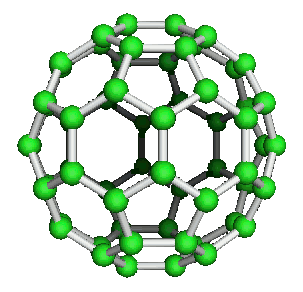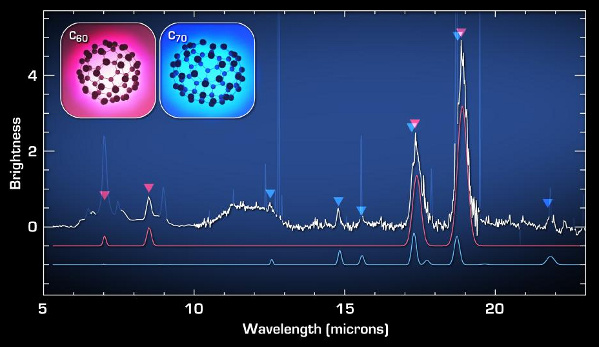Space Balls
July 27, 2010
Fullerenes are large molecules composed solely of carbon. These molecules, constrained by the energetically-stable bonding angles of the carbon atom, can be shaped as spheres, ellipsoids and tubes. The spherical fullerenes (more precisely, the C
60 allotrope) are often called buckyballs, an homage to
Buckminster Fuller, who popularized the
geodesic dome which they resemble. The fullerenes were discovered at Rice University in 1985 by Robert Curl, Harold Kroto and Richard Smalley. A
patent[1] was granted to Smalley in 1993 for an electric arc process for making fullerenes.

Structure of C60.
Although the C
60 fullerene was seemingly a "new composition of matter" when it was discovered, what was patented was not C
60 itself, but a
process to make C
60. This was a good choice. Although C
60 had not been found in nature at the time, I'm sure that Smalley and his collaborators realized that the conditions that existed in their reactor had likely been duplicated in nature, somewhere. According to US patent law[2],
"... a new mineral discovered in the earth or a new plant found in the wild is not patentable subject matter.
As it turns out, buckyballs are produced by something as common as a burning candle, and they are found also in carboniferous mineral deposits.[3] Now, buckyballs have been detected in space, near the remnants of a dying star.[4-6]
Jan Cami of the
SETI Institute, along with several collaborators, have
just published[6] their discovery of C
60 and C
70 in the
planetary nebula, "tc 1." This is Thackeray's Planetary Nebula[7], the remnant of an
O7-type star, located at RA 17h, 45.6m, decl. -46
o 5'. As the
celestial coordinates indicate, this object is in the southern hemisphere, in the constellation
Ara. Their observations were with the
Spitzer Space Telescope, which is capable of observations in the far
infrared wavelengths of light.
This discovery was facilitated by the fact that there's a star in the middle of the nebula that's illuminating it, and the nebula is at the right temperature for infrared measurements, about room temperature. This central star is a
white dwarf, which is an end stage in the
normal evolution of stars. At this stage, stars are expected to contain considerable quantities of carbon. The timing of the discovery may have been fortuitous, Cami thinks that the fullerenes would not have been detected if the observations had been done a few hundred years sooner, or later. He speculates that all planetary nebulae may go through a fullerene phase. The spectra are quite clear, as shown in the figure.

NASA's Spitzer Space Telescope spectrum of buckyballs in space.
As are many scientific discoveries, this discovery was
accidental. Co-author Jeronimo Bernard-Salas of
Cornell University obtained the spectra and noted that the data were unusual. The typical carbon chains and aromatic compounds were absent. His collaborators found a match to C
60 and C
70 and discovered what are the largest molecules known to exist in space. Fullerenes might be important to the evolution of life in the universe.
Space Balls (1987, Mel Brooks, Director) was a parody of the
original Star Wars movie (1977, George Lucas, Director). It's worth viewing, if only for
Daphne Zuniga.
References:
- Richard E. Smalley and Robert E. Haufler, "Electric arc process for making fullerenes," U.S. Patent No. 5,227,038 (July 13, 1993).
- US Patent and Trademark Office, 2105 Patentable Subject Matter.
- Martha Farnsworth, Maclovio Fernandez, and Luca Sabbatini,"Buckyballs: Their history and discovery," CNX.org.
- Jan Cami, Jeronimo Bernard-Salas, Els Peeters, and Sarah Elizabeth Malek, "Detection of C60 and C70 in a Young Planetary Nebula," Science Online Abstract, DOI: 10.1126/science.1192035 (July 22, 2010).
- J.D. Harrington and Whitney Clavin, "NASA Telescope Finds Elusive Buckyballs In Space For First Time," NASA Press Release 10-174, July 22, 2010.
- CBC News, "Buckyballs detected in space," July 22, 2010.
- Irene Klotz, "Buckyballs Found in Space," Discovery, July 22, 2010.
- D.S. Evans and A.D. Thackeray, "A photographic survey of bright southern planetary nebulae," Monthly Notices of the Royal Astronomical Society, vol. 110 (1950), pp.429-439.
Permanent Link to this article